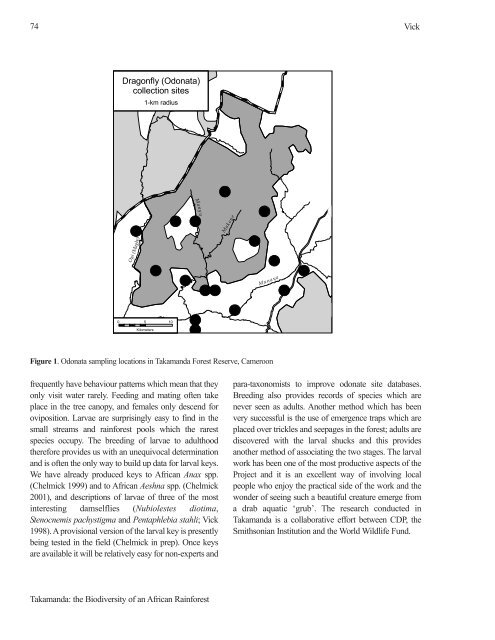Fisheries in the Southern Border Zone of Takamanda - Impact ...
Fisheries in the Southern Border Zone of Takamanda - Impact ...
Fisheries in the Southern Border Zone of Takamanda - Impact ...
Create successful ePaper yourself
Turn your PDF publications into a flip-book with our unique Google optimized e-Paper software.
74<br />
h—2@y——A<br />
2<br />
IE2—<br />
y2@w—˜A<br />
H S IH<br />
u<br />
Figure 1. Odonata sampl<strong>in</strong>g locations <strong>in</strong> <strong>Takamanda</strong> Forest Reserve, Cameroon<br />
frequently have behaviour patterns which mean that <strong>the</strong>y<br />
only visit water rarely. Feed<strong>in</strong>g and mat<strong>in</strong>g <strong>of</strong>ten take<br />
place <strong>in</strong> <strong>the</strong> tree canopy, and females only descend for<br />
oviposition. Larvae are surpris<strong>in</strong>gly easy to f<strong>in</strong>d <strong>in</strong> <strong>the</strong><br />
small streams and ra<strong>in</strong>forest pools which <strong>the</strong> rarest<br />
species occupy. The breed<strong>in</strong>g <strong>of</strong> larvae to adulthood<br />
<strong>the</strong>refore provides us with an unequivocal determ<strong>in</strong>ation<br />
and is <strong>of</strong>ten <strong>the</strong> only way to build up data for larval keys.<br />
We have already produced keys to African Anax spp.<br />
(Chelmick 1999) and to African Aeshna spp. (Chelmick<br />
2001), and descriptions <strong>of</strong> larvae <strong>of</strong> three <strong>of</strong> <strong>the</strong> most<br />
<strong>in</strong>terest<strong>in</strong>g damselflies (Nubiolestes diotima,<br />
Stenocnemis pachystigma and Pentaphlebia stahli; Vick<br />
1998). A provisional version <strong>of</strong> <strong>the</strong> larval key is presently<br />
be<strong>in</strong>g tested <strong>in</strong> <strong>the</strong> field (Chelmick <strong>in</strong> prep). Once keys<br />
are available it will be relatively easy for non-experts and<br />
<strong>Takamanda</strong>: <strong>the</strong> Biodiversity <strong>of</strong> an African Ra<strong>in</strong>forest<br />
w—<br />
w—<br />
w——<br />
Vick<br />
para-taxonomists to improve odonate site databases.<br />
Breed<strong>in</strong>g also provides records <strong>of</strong> species which are<br />
never seen as adults. Ano<strong>the</strong>r method which has been<br />
very successful is <strong>the</strong> use <strong>of</strong> emergence traps which are<br />
placed over trickles and seepages <strong>in</strong> <strong>the</strong> forest; adults are<br />
discovered with <strong>the</strong> larval shucks and this provides<br />
ano<strong>the</strong>r method <strong>of</strong> associat<strong>in</strong>g <strong>the</strong> two stages. The larval<br />
work has been one <strong>of</strong> <strong>the</strong> most productive aspects <strong>of</strong> <strong>the</strong><br />
Project and it is an excellent way <strong>of</strong> <strong>in</strong>volv<strong>in</strong>g local<br />
people who enjoy <strong>the</strong> practical side <strong>of</strong> <strong>the</strong> work and <strong>the</strong><br />
wonder <strong>of</strong> see<strong>in</strong>g such a beautiful creature emerge from<br />
a drab aquatic ‘grub’. The research conducted <strong>in</strong><br />
<strong>Takamanda</strong> is a collaborative effort between CDP, <strong>the</strong><br />
Smithsonian Institution and <strong>the</strong> World Wildlife Fund.

















